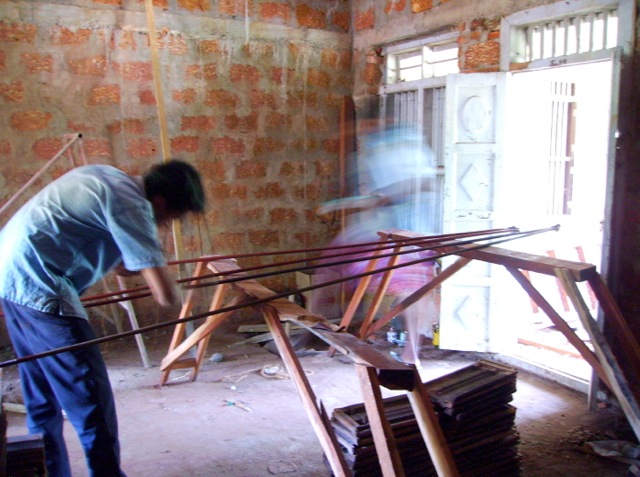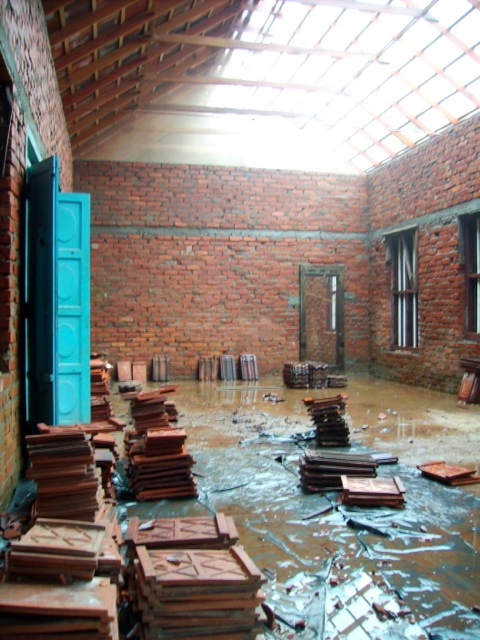When we came back to Kerala in February 2008 we found our Sylviander House in such shape. And in the garden in front of the pond the coconut palms performed their elegant dance – not for ever as we will experience few years later …
While we‘ve been in Germany, the concrete roof was done with the help of our family members. Now we would have 4 weeks only to continue the construction works – or better said, the preparations for the first floor …
Weeks before our arrival in Kerala, Alexander had already organized the workers by phone from Germany. Schedules and the orders for the materials were well fixed. Immediately after our arrival we could start with the works …
Bricks had to be laid on the downstair floor as a preparation for the later terra-cotta paving tiles …
And yes: errors happen! We decided to remove the main entrance door and use it for my writing room. It was a hard job. For the main entrance we installed a stronger door, which we had found recently …
To get an idea, how many doors and windows we still would need, we lifted those up to the first floor, which have been stored in the later massage room. It was quite a task and required many strong hands. These ancient doors and windows of teak wood are really very heavy.
Even more strong hands were needed to lift up the big beam for the stairs to the truck. Our second hand dealer had collected this rare piece for us as well old simple doors, which we would use for the steps …
When we had to return to Germany, visually not much seemed to be happened. But we knew, how much we had done. We had found more doors and windows at the second hand dealer shops in Aleppey and around, had lifted them up to the first floor, selected the place for them and covered them properly to protect against rain – they had to survive the coming monsoon …
Some months later in August 2008 we came back to Kerala. As usual, Alexander had organized the workers and materials already by phone from Germany. As everybody knows, a good planning doesn’t mean, everything works on schedule. There are too many reasons in God’s own Country to disturb and interrupt the work flow by various family functions, festivals and so on …
But since Alexander is an Indian and I have travelled the first time to this huge country in 1977 by land, we are well prepared. Humor is the best remedy to take the challenge :-)
It was raining a lot, which is normal in August. We both love the rain. Rain inspires Alexander a lot for his paintings …
So naturally me too. I once made a shortfilm »rain« some years back for his exhibition »rain« in Bombay.
When it rains in Kerala it is a pleasure, heat cools down and temperature is just pleasant.
This worker was not avoiding not to get wet – he’s waiting for Stephan, the main mason, who is seen in the background arranging the robes to fix this door in the right position. As in the previous posts shown and explained, this is the traditional way to placing doors and windows. Then the wall is built around it.
While the workers were busy with placing doors and windows and building the walls, we often went to town for buying material and also searching for further doors and windows. This task takes a lot of time and patience – it was not easy beside the size to find good quality.
We also made a journey on the beautiful Coastal Highway to Cochin Harbour together with the carpenter, having a look at the ancient Postoffice of Travancore there, which would be demolished soon. We bought all tiles of the whole roof – upper tiles and ceiling tiles. Further we also bought 3 glas windows – 1 for Alexander‘s studio and 2 for my writing room.
On August 16, Alexander travelled with 2 trucks to Cochin Harbour to transport the many tiles of the roof and the 3 windows of the ancient postoffice to Chettikad. This action took a full day plus a half night, complications as police-checks and paying a bribe during the trip was not to avoid.
While I stayed comfortably at home with the family playing with our grandniece and grandnephew …
Many days long we were rubbing and cleaning the tiles with the help of relatives and people of the neighborhood.
Then we went to wood sellers in town with the carpenter to find the right teak trees for the beams of the gable roof. These tree stems would be a rare material we bought newly – the size of our roof made it necessary. These more than hundred years old roof beams of the ancient post office were no more strong and healthy.
It’s a long process to find out which was the best wood. The carpenter knocked on the surface for then listening to the sound for understanding the quality. Finally he chose 4 tree trunks. Which had to be transported to a sawmill for cutting and shaping in the right size for the beams. This work took some days with the help of Alexander and our brother in law.
Then these beams were transported to Sylvianderland, where we polished each beam with sandpaper by hand with the help of our Nephew Vinu. After this exhausting treatment Alexander applied a protective glaze on it to avoid the possible appetite of termites and other wood eating creatures.
On September 1 we had to get up at 4.30 am. It is a ritual that the new house owners lift up the first roof beam themselves before sunrise together with the carpenter. It was still dark and a mystic atmosphere …
Work went on quite smoothly – a good feeling to see the house growing …
While the carpenters worked on the roof of our private rooms, the masons were busy with the guest rooms on the south side of the house …
When the construction of the roof beams was finished, the tilers could start to cover the roof with the rubbed and washed tiles of the ancient post office …
We really had exiting feelings to watch the process …
Especially for me this experience was very unique and extraordinary since I was the architect. Now I could witness how my ideas and imaginations come into reality …
The lot of rains made our rooms look like a mess. We then felt much better, when finally the roof was completed.
We have been really lucky to get this old tiles from the ancient postoffice. The tilers said, they were of much better quality than new ones. In Aleppey these double tiles roofs are unknown, but in Fort Cochin the old houses had these 2 layers of tiles, why they were called Cochin style. Such a roof keeps the house cooler.
It seems in olden times people were more wise how to build a house for such a warm humid climate.
Here we have to think just opposite as in cold Germany. Here we need to have cool and dry rooms to feel comfortable.
When we had to return to Germany end of September our house looked quite like a house.
The roof over our private rooms was completely done and the walls of the guest rooms on the other side were so far finished, waiting for the roof only.
2 months we have spent everyday with the continuation of building our Sylviander House, having done many works by ourselves, controlling the construction, explaining our ideas to the workers, sometimes get slightly mad because of certain results …
Finally we have lost 3 kg weight each!
We could have needed a holiday then, just spending a few days at the nearby Chettikad Beach …
That this beautiful wide beach would shrink in the coming years, we couldn’t anticipate yet …
A last sunset, good-bye Sylvianderland … until next year …
While our absence the carpenters and tilers finished the roof over the guest rooms. Vinu our nephew has sent us later the photographs of the completed roof.
Still a lot of work is waiting for the years to come …
Also see previous posts about the construction of Sylviander House:
(Label) Sylviander House (3.12.2014)
(Post Title) First Stone Laying
(Label) Sylviander House (16.12.2016)
(Post Title) Building a House in Kerala – the Ground Floor
German speaking people can read more about our Sylviander House construction and shifting from Germany to India in my story »Schabdam in God‘s own Country« in the anthology »Indien, wie wir es sehen« at the Drachenmond Verlag, Germany.
Enjoy :-)
Text & pictures by Sylvie Bantle (www.sylviebantle.info), last picture by Vinu Varghese



























No comments:
Post a Comment